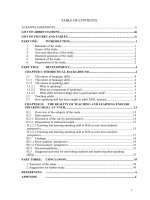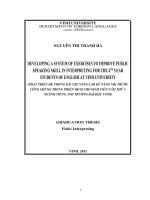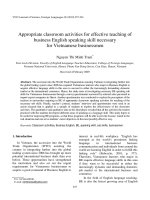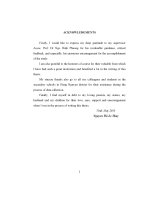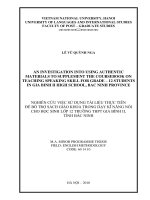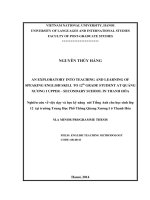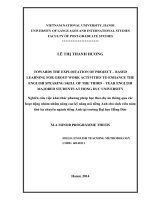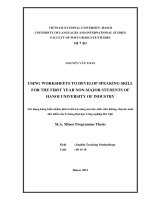Teaching speaking skill for non-major ma students of english at vnuh
Bạn đang xem bản rút gọn của tài liệu. Xem và tải ngay bản đầy đủ của tài liệu tại đây (298.48 KB, 59 trang )
TABLE OF CONTENTS
ACKNOWLEDGEMENTS..........................................................................................................ii
LIST OF ABBREVIATIONS...................................................................................................iii
LIST OF FIGURES AND TABLES........................................................................................iv
PART ONE:
1.
2.
3.
4.
5.
6.
INTRODUCTION.......................................................................................1
Rationale of the study................................................................................................1
Scope of the study......................................................................................................1
Aim and objectives of the study................................................................................2
Research questions of the study.................................................................................2
Methods of the study.................................................................................................2
Organization of the study...........................................................................................2
PART TWO:
DEVELOPMENT.......................................................................................4
CHAPTER I: THEORETICAL BACKGROUND.............................................................4
I.1
The nature of language skills.....................................................................................4
I.1.1 The nature of language skills.....................................................................................4
I.1.2 The nature of speaking skill.......................................................................................4
I.1.2.1
What is speaking?................................................................................................4
I.1.2.2
What are components of speaking?.....................................................................5
I.1.2.3
What skills and knowledge does a good speaker need?......................................7
I.2
Teaching adults..........................................................................................................8
I.3
How speaking skill has been taught to adult ESOL learners.....................................9
CHAPTER II: THE REALITY OF TEACHING AND LEARNING ENGLISH
SPEAKING SKILL AT VNUH..........................................................................................13
II.1 Overview of the subjects of the study......................................................................13
II.2 Data analysis............................................................................................................14
II.2.1 Discussion of the survey questionnaires..................................................................14
II.2.2 Presentation of statistical results..............................................................................15
II.2.2.1 Teaching and learning speaking skill at SGS as seen from students’
perspective..........................................................................................................................15
II.2.2.2 Teaching and learning speaking skill at SGS as seen from teachers’
perspective..........................................................................................................................17
III.1 Findings...................................................................................................................19
III.1.1 From students’ perspective......................................................................................19
III.1.2 From teachers’ perspective......................................................................................21
III.2 Recommendations....................................................................................................21
III.3 Suggested activities for motivating students and improving their speaking
ability .................................................................................................................................27
PART THREE:
CONCLUSION.........................................................................................43
1. Summary of the study.....................................................................................................43
2. Suggestions for further study..........................................................................................43
REFERENCES
......................................................................................................................A
APPENDIX
......................................................................................................................C
i
ACKNOWLEDGEMENTS
I am grateful to those who have contributed to this thesis and proud to acknowledge their
help.
I would like first and foremost to express my sincere gratitude and appreciation to my
supervisor, Ms. Phan Thi Van Quyen, for her inspiring and invaluable guidance, advice,
encouragement and everything that I learnt from her throughout my work. Without her this
thesis would not have been possible.
My sincere thanks also go to all lecturers and the staff of the Department of Post Graduate
Studies at College of Foreign Languages, Vietnam National University for their useful
lectures, assistance and enthusiasm during my course.
Special acknowledgement is also given to my colleges and former MA students of law,
technology, economics, education and business administration at Vietnam National
University Hanoi, who have been very supportive in filling the survey questionnaires.
Last but not least, I am greatly indebted to my husband and my family for their
understanding, patience and support during the entire period of my study.
Nguyễn Thị Thu Hương
ii
LIST OF ABBREVIATIONS
AOL
Age Of Learning
C
Consonant
CLT
Communicative Language Teaching
ESOL
English for Speakers of Other Languages
MA
Master of Arts
SGS
School of Graduate Studies
TEFL
Teaching English as a Foreign Language
TESOL
Teaching English to Speakers of Other Languages
VNUH
Vietnam National University, Hanoi
V
Vowel
iii
LIST OF FIGURES AND TABLES
Figure 1: Units of spoken language.
Table 1: Speaking activities and topics/drills in the course book ‘English for Graduate
Students’.
Table 2: What make students interested in speaking in English class.
Table3: What make students unwilling to speak in English class.
Table 4: Students’ assessment of classroom speaking activities given by teachers.
Table 5: Teachers’ difficulties in teaching speaking for MA students at SGS.
Table 6: What teachers do to motivate students to speak in class.
Table 7: Suggested ideas for discussion.
Table 8: Activities suitable for each unit in the course book ‘English for Graduate
Students’.
iv
PART ONE: INTRODUCTION
1.
Rationale of the study
Today, English is the language of globalization, international communication, commerce,
the media and pop culture, and thus, affects motivations for learning English. English is no
longer seen as the property of the English-speaking world but as an international
commodity sometimes referred to as World English or An International Language.
In Vietnam, foreign languages, with English as the most studied, have become a
compulsory subject at schools and colleges. Many students begin their learning English
when they are ten years old. City children even have their first lessons of English as early
as they attend primary school. As for MA students of laws, economy, technology,
education and business administration at VNUH, the minimum time of dealing with
English before their MA course is 420 class contacts (approximately 315 hours). They are
supposed to be of pre-intermediate level of English before having another 150 class
contacts as a compulsory part of their MA course at VNUH. However, it is surprising to
learn that many of these students are incapable of using their English to talk, even in class.
What is more, the same situation exists in many other colleges and universities in Vietnam.
There have been numerous studies on this situation and various solutions,
recommendations and suggestions have been given, including changing teaching methods,
changing syllabus or textbooks, upgrading teachers’ qualifications, changing formats of
speaking tests and so on. At SGS – VNUH, which is in charge of teaching English for MA
students at VNUH, no such a research has been done before. The author, as a full-time
teacher at SGS, is more than aware of the situation and she herself has encountered a
number of difficulties in helping her students improve their speaking skill. This actually
drives her to this research, namely “Teaching speaking skill for non-major MA students at
VNUH”.
2.
Scope of the study
To improve speaking skill for non-major MA students of English at VNUH, various
methods can be made used of. However, within the framework of a minor thesis, the author
only intends to give an overview of the current situation of teaching and learning speaking
skill at SGS – VNUH and to suggest activities to help teachers improve their students’
speaking skill and achieve the objectives of each unit of the course book as well. The
suggested activities will serve as a reference for teachers to teach effectively speaking
topics in the course book English for Graduate Students only.
1
3. Aim and objectives of the study
Within the framework of a minor MA thesis, the study aims at suggesting classroom
activities with the hope that they would be helpful, in one way or another, for teachers in
their teaching English speaking skill to non-major MA students of English at VNUH.
To achieve this aim, the objectives are to investigate the current situations of learning and
teaching of speaking skill to non-major MA students of English at VNUH in order to find
out the reasons for students’ unwillingness to speak English as well as teachers’ problems
in teaching speaking skill.
4. Research questions of the study
The researcher wish to raise the questions as follows:
-
What are the factors affecting willingness of non-major MA students of
English to speak in class?
-
What difficulties do teachers encounter in teaching English speaking skill
for these students?
5. Methods of the study
To complete the study, quantitative method was used. Two survey questionnaires and some
short interviews were given to non-major MA students of English at SGS – VNUH and
their teachers to collect information for the study. All comments, remarks, suggestions and
conclusion provided in the study based on the analysis of the data collected from these
surveys.
6. Organization of the study
The study consists of three parts.
Part one, INTRODUCTION, presents the rationale and the scope of the thesis, defines the
aim and objectives of the study. The research questions, methods and organization are also
mentioned in this part.
Part two, DEVELOPMENT, includes the following three chapters:
-
Chapter one, Literature Review, covers the concepts relevant to the study: the
nature of language skills and communication, the nature of speaking skill, in
which answers to the questions: What is speaking? What are components of
speaking? What skills and knowledge does a good speaker need? are found.
Then the author discusses what skills and knowledge a good speaker needs.
2
Methods and approaches most frequently applied so far in the teaching of
speaking skill are also reviewed in this part.
-
Chapter two, namely Teaching and Learning English Speaking skill at SGS –
VNUH, provides an analysis of the current situation of teaching and learning
speaking skill here based on the result of interviews and surveys of student’s
attitude towards the current teaching methods and activities applied by the
teachers in class, and teachers’ opinions about the course book.
-
Chapter three, Some suggested activities for teaching English speaking skill at
SGS, presents activities designed for each unit of the course book with the hope
that they would help the teachers in creating motivation and improving
students’ ability to speak English.
Part three, CONCLUSION, summarizes the findings and addresses the shortcomings of the
study. It also gives suggestions for further researches and studies.
3
PART TWO:
DEVELOPMENT
CHAPTER I: THEORETICAL BACKGROUND
I.1
The nature of language skills
I.1.1
The nature of language skills
Language has been divided into different skill areas, based on the purpose of analysis and
instruction. Regarding teaching points of view, language skills mainly consist of fourmacro skills: listening, speaking, reading and writing, in which speaking and writing are
productive skills and listening and reading are receptive skills (Byrne, 1988:8). Regarding
the manners by which they are formed, language skills are divided into oral skills relating
to articulately organs, which are listening and speaking and literacy skills in connection
with manual script including reading and writing.
Of the four skills, speaking plays a role of great importance. It is central to the business of
teaching and learning, in every discipline and at every level of instruction. It defines who
knows or does not know a language. One cannot say he knows English without his ability
to use the language to talk and once a person can speak in English, people say he knows
the language without knowing if he can read or write it or not.
I.1.2
The nature of speaking skill
I.1.2.1 What is speaking?
Speaking is “an interactive process of constructing meaning that involves producing and
receiving and processing information” (Brown, 1994; Burns & Joyce, 1997). Its form and
meaning are dependent on the context in which it occurs, including the participants
themselves, their collective experiences, the physical environment, and the purposes for
speaking. It is often spontaneous, open-ended, and evolving. Speaking requires that
learners not only know how to produce specific points of language such as grammar,
pronunciation, or vocabulary ("linguistic competence"), but also that they understand
when, why, and in what ways to produce language ("sociolinguistic competence"). It has
its own skills, structures, and conventions different from written language (Burns & Joyce,
1997; Carter & McCarthy, 1995; Cohen, 1996). A good speaker synthesizes these skills
and knowledge to succeed in a given speech act.
4
I.1.2.2 What are components of speaking?
This section examines the components of spoken English, drawing on a model proposed by
van Lier (1995). It is necessary for teachers to understand fully these interrelated
components in order to help adult learners improve their speaking skill.
PHONOLOGY
distinctive
feature
phoneme
syllable
MORPHOLOGY
morpheme
word
SYNTAX
phrase
clause
STRESS
RHYTHM
INTONATION
utterance
DISCOURSE
text
Figure 1: Units of spoken language (van Lier, 1995, p.
15).
The figure depicts the many elements involved in teaching speaking to adult ESOL
learners. The left column lists four traditional areas of linguistic analysis (which teachers
must understand), and the center column labels the units of spoken language (which
learners must master).
Beginning at the pyramid’s base, text refers to stretches of language of an undetermined
length. Texts can be either written or spoken, but here the focus is exclusively on spoken
discourse. Spoken texts are composed of utterances: what someone says. A clause is two
or more words that contain a verb marked for tense and a grammatical subject.
5
Independent clauses are complete sentences that can stand alone (“Tuan went to work”),
whereas dependent clauses cannot (“While Tuan was going to work . . .”). In contrast, a
phrase is two or more words that function as a unit but do not have a subject or a verb
marked for tense. These include prepositional phrases (“in the hospital” or “after school”)
and infinitive phrases (“to drive” or “to move up”). Clauses and phrases do not usually
appear alone in formal writing, but they are quite common in speech. Both clauses and
phrases can be utterances, as can individual words, the next level in the pyramid.
A word is called a free morpheme—a unit of language that can stand on its own and
convey meaning (bus, apply, often). In contrast, bound morphemes are always connected to
words. These include prefixes, such as un- or pre-, as well as suffixes, such as -tion or -s or
-ed. Often, during the pressure of speaking, it is difficult for Vietnamese learners English
to use the expected suffixes because Vietnamese language does not utilize these kinds of
morphemes as grammatical markers.
A phoneme is a unit of sound that distinguishes meaning. Phonemes can be either
Consonants (like /p/ or /b/ in the words pat and bat) or Vowels (like /I/ and /æ/ in bit and
bat). Phonemes differ from English to Vietnamese and are therefore difficult for learners to
pronounce. For example, the “th” sounds in think and the are pervasive in English but do
not exit in Vietnamese language. Learners of English, especially adult ones, often
approximate or replace the “th” sounds with “s” or “z” or “d”.
In the top levels of the figure, the word syllable overlaps the levels of morphemes and
phonemes because a syllable can consist of a morpheme or simply one or more phonemes.
The structure of syllables is referred to as being either open (ending with a V) or closed
(ending with a C). Vietnamese languages use the open syllable structure, in which a
syllable consists of just a V, or of a C followed by a V. Spoken English, in contrast, allows
both open syllables (C-V, or just V) and closed syllables (C-V-C, or simply V-C), as well
as C clusters, where two or more Consonants occur in sequence (as in the words stretched
or jumped). For this reason, Vietnamese learners of English may omit word-final
Consonants, thereby eliminating the sounds that convey important linguistic information,
such as plurality, possession, or tense.
Consonants and vowels are called segmental phonemes. Sometimes a spoken syllable
consists of one phoneme (/o/ in okay). Syllables also consist of combined sounds (the
second syllable of okay), and of both free and bound morphemes. For instance, the free
6
morpheme hat consists of three phonemes but only one syllable. The word disheartened
has three syllables, four morphemes (dis + heart + en + ed), and nine phonemes.
A smaller unit, the distinctive feature, relates to how and where in the mouth a sound is
produced when we speak. These minute contrasts contribute to ESOL learners’ accents.
The three other labels in The figure—stress, rhythm, and intonation represent the
suprasegmental phonemes. When we speak, these phonemes carry meaning differences
“above” the segmental phonemes. For instance, the sentence “I am going now” can convey
at least four different meanings, depending on where the stress is placed. The differences
are related to the context where the utterances occur. Consider these interpretations:
I am going now. (You may be staying here, but I choose to leave.)
I am going now. (You may assert that I’m staying, but I insist that I am leaving.)
I am going now. (I insist that I am leaving, rather than staying.)
I am going now. (I am not waiting any longer.)
It is critical to know how these levels of spoken language relate to the speaking skill of
Vietnamese learners. Two key points derive from a substantial review of the research on
foreign accent by Major (2001). First, he says that really learning the sound system of a
language entails mastering (a) the individual segments (the V and C phonemes), (b) the
combinations of segments, (c) prosody (stress, intonation, rhythm, etc.), and (d) “global
accent, or the overall accent of a speaker” (p. 12). He adds that a global foreign accent is
the result of a nonnative combination of (a), (b), and (c).
Second, Major (2001) notes that “both the learner’s age and the AOL (when the learner
was first exposed to the language) have been found to be important variables in governing
whether and to what degree a learner can acquire a native like accent” (pp. 6–7). He
concludes that “the vast majority of the research indicates that the younger the learner the
more native like the pronunciation” (p. 11).
I.1.2.3 What skills and knowledge does a good speaker need?
A speaker's skills and speech habits have an impact on the success of any exchange (Van
Duzer, 1997). Speakers must be able to anticipate and then produce the expected patterns
of specific discourse situations. They must also manage discrete elements such as turntaking, rephrasing, providing feedback, or redirecting (Burns & Joyce, 1997). Other skills
and knowledge that instruction might address include the following:
7
-
producing the sounds, stress patterns, rhythmic structures, and intonations of the
language;
-
using grammar structures accurately;
-
assessing characteristics of the target audience;
-
selecting vocabulary that is understandable and appropriate for the audience, the
topic being discussed, and the setting in which the speech act occurs;
-
applying strategies to enhance comprehensibility;
-
using gestures or body language; and
-
paying attention to the success of the interaction and adjusting components of
speech.
I.2
Teaching adults
Adults bring life experiences and a level of maturity into the classroom that children and
adolescents do not. Their expectations and motivations reflect this. Here are several keys to
keep in mind when teaching adults:
-
Adult classrooms may present great diversity
Be prepared for diversity of cultural background, age, previous formal education,
previous exposure to English, life experiences, and current life situations.
-
Adults respond well to knowledgeable, enthusiastic teachers
You must be comfortable with the subject matter you are teaching and
communicate enthusiasm for the subject matter and your role as a teacher. This will
help you gain respect and is especially important if you are younger than your
students. If you must teach material which is challenging for you, try not to
communicate a negative attitude about the material to your students. If a student
asks a question which you can't answer, don't be afraid to say, "I don't know, but I'll
find out for you."
-
Adults are not too old to learn a second language well
Although native language learning and literacy are best accomplished in childhood,
when it comes to learning a second language, research has shown that adolescents
and adults outperform children. Adolescents even surpassed children in
pronunciation skills. One of the reasons children appear to acquire a second
8
language faster than adults is simply that they get a lot more practice with other
children and have lower inhibitions, but many adults have attained a high level of
fluency in a foreign language.
-
Adults need a comfortable and safe learning atmosphere
Trial and error should be encouraged in language learning. Adults will take more
risks in an environment where it's safe to make mistakes without embarrassment.
You may want to minimize public reading and writing until your learners gain
confidence, especially if literacy skills are deficient. The same goes for standing in
front of the group to speak.
-
Adult learning is transformative
Learning in childhood is said to be formative, when skills and concepts are
developed for the first time. Adults, on the other hand, are extending and refining
their knowledge based on existing knowledge and beliefs. They are changed or
transformed by learning experiences.
-
Adults need repeated practice of a concept or skill
Adults generally need patience and repetition to solidify new language concepts or
skills. If adults have already developed bad habits with English errors, these will
take time and effort to break. Adults also tend to have a lot on their minds and
limited time to practice English outside the classroom.
-
Adults learn well with question asking and answering, and problem finding
and solving
These activities require mature thought processes which stimulate and motivate
adult minds.
-
Adults want practical, real-life contexts
The more relevant and useful the subject matter, the more motivated your learners
will be. Adults enjoy materials that relate to their personal experiences and
interests, and they want to be able to apply what they're learning in the real world.
I.3
How speaking skill has been taught to adult ESOL learners
Although several language teaching methods have been used to teach speaking in a second
or foreign language, three methods have dominated language teaching in the past 60 years.
9
This section first briefly reviews each method, then focuses specifically on how the method
treats the speaking skill of adult ESOL learners.
The Grammar-Translation Method
In the grammar-translation method, students are taught to analyze grammar and to translate
(usually in writing) from one language to another. The key instructional goal is to read the
literature of a particular culture. According to Richards and Rodgers (1986), the main
characteristics of the grammar-translation method are:
-
reading and writing are the major focus;
-
the vocabulary studied is determined by the reading texts;
-
the sentence is the basic unit of teaching and language practice”;
-
the primary emphasis is on accuracy;
-
teaching is deductive (i.e., grammar rules are presented and then practiced through
translating); and
-
the medium of instruction is typically the students’ native language.
The grammar-translation method does not prepare students to speak English, so it is not
appropriate for nonacademic adult ESOL students who want to improve their speaking
skill. The method is not consistent with the goals of increasing fluency, oral production, or
communicative competence of adult ESOL learners. In grammar-translation lessons,
speaking consists largely of reading translations aloud or doing grammar exercises orally.
There are few opportunities for expressing original thoughts or personal needs and feelings
in English.
The Audio-lingual Method
The audio-lingual method dominated English-language instruction for many years. In this
method, speaking skill is taught by having students repeat sentences and recite memorized
textbook dialogues. The theory behind the audio-lingual method is that students learn to
speak by practicing grammatical structures until producing those structures become
automatic. Then, it is thought, the learners would be able to engage in conversation. As a
result, “teaching oral language was thought to require no more than engineering the
repeated oral production of structures . . . concentrating on the development of
grammatical and phonological accuracy combined with fluency” (Bygate, 2001, p. 15).
10
The theoretical basis of the audio-lingual method behaviorist is the concept of good habit
formation. This theory proposes that for learners to form good habits, language lessons
must involve frequent repetition and correction. Teachers address spoken errors quickly, in
hopes of preventing students from forming bad habits. If errors are left untreated, both the
speaker and the other students in class might internalize those erroneous forms. There is
little or no explanation of vocabulary or grammar rules in audio-lingual lessons. Instead,
intense repetition and practice are used to establish good speaking habits to the point that
they are fluent and automatic - that is, adult ESOL learners would not have to stop and
think about how to form an utterance before speaking.
Audiolingualism “rapidly lost popularity, partly as a result of the strong theoretical
arguments that were advanced against it, but also because the results obtained from
classroom practice were disappointing” in several ways (Ellis, 1990, p.29). Many learners
lost interest in language learning because the pattern practice and audio-lingual drills were
boring. Adult learners often felt hampered because the method downplayed the explicit
teaching of grammar rules. In addition, the memorization of patterns “did not lead to fluent
and effective communication in real-life situations” (p.30).
“While audiolingualism stressed oral skills (evidenced by the amount of time spent in the
language laboratory practicing drills), speech production was tightly controlled in order to
reinforce correct habit formation of linguistic rules” (Lazaraton, 2001, p. 103). This sort of
tightly controlled practice does not necessarily prepare learners for the spontaneous, fluid
interaction that occurs outside the classroom.
Communicative Language Teaching
During the 1970s and 1980s, language acquisition research (and dissatisfaction with the
audio-lingual method) made TESOL professionals reconsider some long-standing beliefs
about how people learn languages. As a result, communicative language teaching arose.
CLT is an approach to the teaching of second and foreign languages that emphasizes
interaction as both the means and the ultimate goal of learning a language.
In this method teachers often downplay accuracy and emphasize students’ ability to convey
their messages (Hammerly, 1991). Accuracy is the extent to which the adult ESOL
learners’ speech matches the native speaker norms. Fluency is the speed, ease, and
naturalness with which ESOL learners communicate orally. Proficient speakers are both
fluent and accurate, but at the lower levels, fluency and accuracy often work against one
11
another. That is, to be accurate and apply learned rules, adult ESOL learners may speak
hesitantly or haltingly. To be fluent in conversation, they may overlook the timeconsuming application of rules. The instructional implications are that teachers should not
focus only on accuracy, but should use both form-focused and fluency building activities in
adult ESOL classes.
In some language teaching methods, such as Total Physical Response, the focus is on
input-based activities. In contrast, communicative language teaching methods feature more
interaction-based activities, such as role plays and information gap tasks. Curricular
choices, such as task-based and project-based activities also promote interaction. Pair work
and group work are typical organizational features of interaction-based lessons in
communicative language teaching.
Recent critiques of CLT include an article by Stephen Bax entitled: "The end of CLT: a
Context Approach to language teaching" in which he argues that the dominance of CLT
has led to the neglect of one crucial aspect of language pedagogy, namely the context in
which that pedagogy takes place. Bax argues that it is time to replace CLT as the central
paradigm in language teaching with a Context Approach which places context at the heart
of the profession. The article argues that such a shift is taking place already and will
eventually change our practice radically.
Concluding remark
It can be drawn out that of all the approaches stated above, which have dominated
language teaching in the past 60 years throughout the world, the first two, i.e., the
Grammar-Translation method and the Audio-lingual method, have proved to be of less use
in the current teaching of speaking skill, especially that to adult learners, whose
characteristics regarding psychology, mindset and ability in learning to speak English
require productive methods rather than inactive ones.
12
CHAPTER II:
II.1
THE REALITY OF TEACHING AND LEARNING ENGLISH
SPEAKING SKILL AT VNUH
Overview of the subjects of the study
II.1.1 Students
The thesis studies MA students of laws, economy, technology, education and business
administration at VNUH. The students’ age varies from 22 to about 50. Almost those under
30, who account for more than 50 percent of all students, finished 420 class contacts
(equivalent to 315 hours) of English at university. Some even had a longer time of learning
English at schools. The rest do not have so much time learning English and many of them
have not used English for a long time. Despite the difference in age and the time of
acquiring English, to become an MA student at VNUH, almost all of them must pass the
English entrance exam at pre-intermediate level. Those who already have a certificate of
English at the equivalent or higher level are exempted from that exam. At SGS – VNUH
they have to continue to learn English as a compulsory subject.
II.1.2 Teachers
Almost all the teachers of English at SGS have got MA degree in TEFL and at least several
years of teaching experience. The rest are about to finish their MA course. The majority of
them are from VNUH, some from Hanoi University of Education. Only 20 percent of them
are working as full-time teachers at SGS – VNUH.
II.1.3 Course book
The course book is Intermediate English for Graduate Students, published in 2004 by SGS
– VNUH and has ever since been used as an official course book. It was adapted from New
Headway Intermediate, by Liz & John Soars, to fit students’ level of English and
educational goals of the universities. Intermediate English for Graduate Students was,
according to what is stated in the Introduction, intended to be
“communicative oriented and inclusive of the four language skills: listening,
speaking, reading and writing as well as language components: phonetics,
grammar and vocabulary. There are 10 units, each accompanies with a topic
familiar to learners and includes such parts as grammar, vocabulary, practice
exercises and communicative skills”.
However, the course book appears to
focus on grammar and grammar exercises other than communication skills.
13
This can be easily noticed on the very first page of the book, which presents
each unit with a topic and all grammar items it is about, without any skills
named. As considerations go further to contents of each unit, this seems to be
proved right. Activities for speaking skill, for example, are not found to
appear until unit four. To be more detailed, all activities and topics or drills in
terms of speaking skill in the course book are presented as the following.
Unit
Speaking activities
Topics/drills
1
None
2
None
3
None
4
Discussion
Tourism
6
Discussion
Retirement
7
Dialogue completion
Second conditional
Discussion
Money, life, work
Doing charity
8
9
Text completion
Modals of probability
Pair work
Personality
Discussion
Children and family size
Answering questions
Different views of smoking
Collecting things
10
Information gap
Famous people
Table 1: Speaking activities and topics/drills in the course book ‘English for Graduate Students’
It can be learned from the table that the variety of speaking activities is very limited, with
discussion as the most common. It therefore depends very much on teachers’ experience
and enthusiasm to design speaking activities that motivate students and improve their
speaking ability.
II.2
Data analysis
II.2.1 Discussion of the survey questionnaires
To collect information concerning the current situation of teaching and learning speaking
skill at SGS – VNUH, the author conducted two survey questionnaires; one was delivered
to 100 students and the other to 12 teachers of English at SGS. To answer the question in
14
the survey questionnaires, informants may have more than one choice, so the total
percentage of the answers to a certain question may not equal 100 percent.
The first questionnaire was designed for the students with three questions:
Question 1: What make you interested in speaking in English class?
Question 2: What make you unwilling to speak in English class?
Question 3: Does your teacher often introduce classroom speaking activities?
The second questionnaire is designed for the teachers and consists of two questions.
Question 1: What are your difficulties in teaching speaking for MA students at SGS?
Question 2: What do you do to motivate students to speak in class?
100 copies of the questionnaire delivered to the students and 12 copies of the questionnaire
delivered to the teachers have been all responded.
II.2.2 Presentation of statistical results
II.2.2.1 Teaching and learning speaking skill at SGS as seen from students’
perspective
Option
C. My teacher gives me more attention because I speak English better than other
students in the class.
B. My teacher always encourages me to speak, even when I make a lot of
mistakes in speaking.
F. I like speaking activities and games.
D. I can express my ideas in English easily.
E. I feel confident in speaking English in front of others.
G. I’m accustomed to practicing speaking in class.
A. Topics are interesting/familiar.
%
27
23
22
15
15
8
7
Table 2: What make students interested in speaking in English class
The low percentages in table 1 reveal the fact that there is hardly anything attractive
enough to encourage a large number of students to speak.
27% students speak because of the attention they receive from their teachers as they speak
English better than other students. Other factors involving students into speaking in class
are teachers’ encouragement and activities or games, which respectively receive response
from 23% and 22% of the students. Subjective factors like students’ good ability and high
confidence in speaking English make only 15% of them interested in speaking in class.
15
Some are accustomed to speaking in English class and some find topics are interesting and
familiar to speak about (8% and 7% respectively).
Students also specified other factors affecting their interest in speaking in class such as
their wishes to improve speaking skill and be able to communicate with foreigners.
Option
I. I’m tired after a working day.
A. Topics are boring/unfamiliar.
D. I can’t find exact words to express my ideas.
G. I’m not accustomed to speaking English in class (It’s my habit to sit in class and
listen quietly to teachers until I’m asked to speak).
C. I’m afraid that my classmates will laugh at me if I make mistakes.
B. My teacher often corrects my mistakes when I’m speaking.
H. It’s ok if I don’t speak. The teacher never complains about that.
E. My teacher hardly ever pays attention to me.
F. My teacher and other students speak almost all the time.
%
72
56
53
52
39
29
28
25
23
Table3: What make students unwilling to speak in English class
Statistics provided in table 3 prove to be well-matched with those in table 2. It seems that
many students share the same reasons for their being uninterested in classroom speaking
activities.
Circumstance makes up the largest proportion of the reasons for students’ unwillingness to
speak. 72% of them state that they are too tired to go to class. This is because almost all
MA students at VNUH go to work during day time and attend their classes in the evening.
It is very common that they enter the class with “an exhausted body and an empty
stomach”, as one student noted in the questionnaire.
Many students (56%) blame boring/unfamiliar topics for discouraging them to speak in
class and a similar number (53%) state that they are not interested in speaking as they
cannot find exact words to express their ideas.
Students who are not active in class make up the rate of 52%. They are passive and only
speak when they are asked to, especially 28% of them who are never complained by the
teachers for their not speaking in class.
Another factor that should be taken into consideration is students’ wish to save face.
Although they are adult learners, 39% of them are afraid of making mistakes and do not
want to be laughed at. For this reason, 29% do not like it when teachers interrupt them to
correct their mistakes. This discourages them a lot.
16
